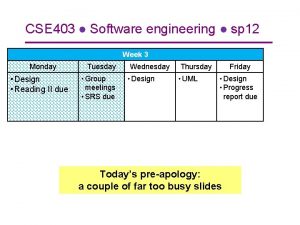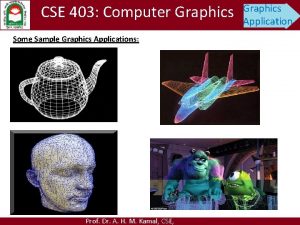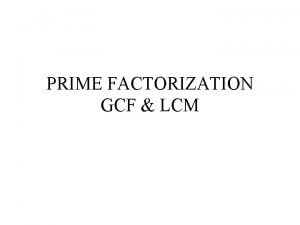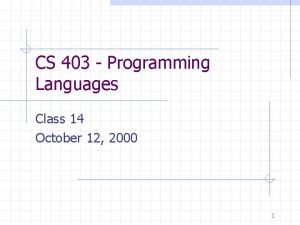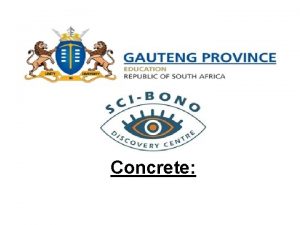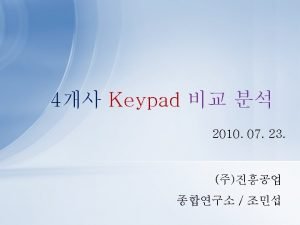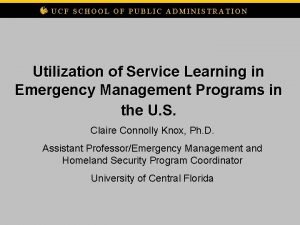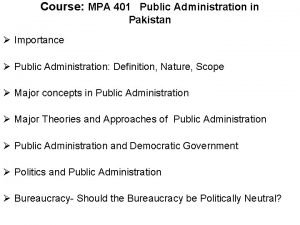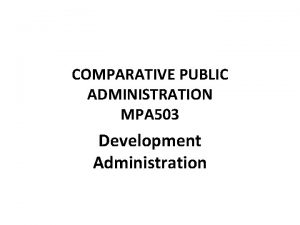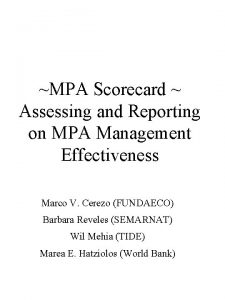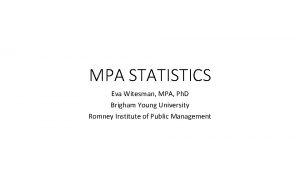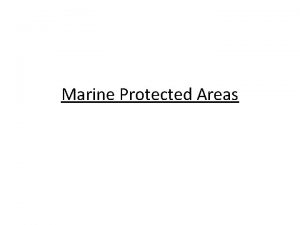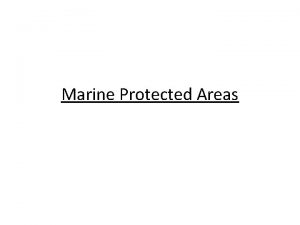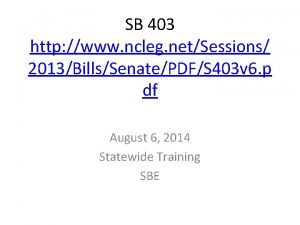1 Development Planning and Administration MPA 403 Lecture































- Slides: 31

1

Development Planning and Administration MPA – 403 Lecture 25 FACILITATOR Prof. Dr. Mohammad Majid Mahmood Bagram

Reflections 3

Some will never see the inside of the school 4

5

Educational Planning issues & strategies 6

Effective Planning………. Creating Success 7

Where Does Planning Fit? 8

Putting the Pieces Together… 9

Small Business Center ent m op areer Ma l nagemen eve D e rc o f k or t W b Jo Every wher e! u in t n o Customized Training du E ing k n i L n io t a c C Curriculum 10

In this age, it is easy to reach outer space or any part of the world within a relatively short time, but it is still a major problem to transmit/get knowledge even to/from our next door colleague. 11

• Education is an instrument of socioeconomic and political change for the better. Without education, there is ignorance, and ignorance leads to poverty, poverty leads to disease and disease leads to death. 12

National Commitments of Pakistan Constitution of Pakistan (1973) State shall be responsible for: “ eradication of illiteracy and provision of free and compulsory education up to secondary level, within minimum possible time” (Article 37 -B, 1973 Constitution of Pakistan) 13

Pakistan`s Commitment 86% literacy to be achieved by 2015 (Ministry of Education) 14

Human Development in South and West Asia (Source: Human Development Report 2008 -09, and UNESCO EFA Global Monitoring Report 2009) Country Public expenditure on Education as % of GDP India 3. 3 Iran 5. 2 Pakistan 1. 25 Sri Lanka 5. 4 Maldives 8. 3 Nepal 3. 2 Bangladesh 2. 8 15

Education Budget in Pakistan: (1995 -96 to 2008 -09) (Source: Economic Survey, Finance Division – Government of Pakistan, EFA Global Monitoring Report 2008, 2009, and other related documents of Govt. of Pakistan) Year % of GDP 1995 -96 1996 -97 1997 -98 1998 -99 1999 -00 2000 -01 2. 00 2002 -03 1. 7 2. 62 2003 -04 2. 20 2. 34 2004 -05 2. 12 2. 40 2005 -06 2. 40 1. 7 2006 -07 2. 42 1. 6 2007 -08 2. 49 2001 -02 1. 9 2008 -09 1. 25 16

PRE-CONDITIONS FOR SUCCESS OF EDUCATIONAL PROGRAMS • Vision: – Literacy programs based on an agenda of social change including functional literacy/income generation skills – learners can not be attracted just for alphabets-” Literacy for a cause” – Including post-literacy and continuing education: beyond basic literacy • Leadership : literacy movement demands leadership, not merely the funds • Organizational structure : expertise for training, material development, research & evaluation • Consistent policy and approach 17

AN ANALYSIS OF EDUCATIONAL PROGRAMS IN PAKISTAN 1. Commitment gap : 2. Policy Gap: A clear and strong policy on education is missing. 3. Organizational Gap : Absence of permanent organizational structure – led to coordination gap 4. Financial Resources Gap : limited financial assistance, and uncertainty about funding 5. Technical Capacity Gap : 18

Misery Index Pakistan ranks among the bottom five countries of the world, as far as the public expenditure on education, as a percentage of total public spending is concerned 19

Misery Index Despite the government’s claims that education is its top priority, public spending on it during 2008 -09 is 1. 25% of the GDP against the UNESCOrecommended norm of a minimum of 4%. 20

q 15% of government schools are without buildings q 52% are without boundary walls q 40% are without water q 71% are without electricity q 57% are without toilets 21

Of the millions of people added to the population every year, some only work to earn their livelihood. 22

Educational Sector of Pakistan ISSUES 23

Issues in Educational Sector Low access rate lack of confidence in the public sector schools to deliver quality education parents either shift their kids to private schools or absorb additional financial burden by arranging private tuitions. If neither is affordable the households prefer to have their children drop out from school and join income earning activities. The average student of the public sector education system cannot compete in the job market and it leads to social exclusion of the already poor. Teachers absenteeism, ghost schools, cheating in examinations are a widespread phenomenon. Primary sufferers are the most poor and underprivileged in the system. 24

Issues in Educational Sector Implementation Gap • Mismanagement of allocation and use of resources • Amounts of allocated development funds remaining unutilized. • Lack of planning • Lack of accountability • Lack of constant monitoring 25

Issues in Educational Sector Equity in education There is a divide between the prevalent school structure and differences in levels of infrastructure and facilities, media of instruction, emolument of teachers, and even examination systems between public and private schools. The rich send their children to privately-run English medium schools which offer foreign curricula and examination systems; the public schools enroll those who are too poor 26

Issues in Educational Sector The Gender Bias starts early within the family keeps women at disadvantageous position discriminatory social norms missing incentives lack of access to educational institutions educational expenses household duties parental ignorance 27

Issues in Educational Sector • Quality of provision – Teacher/Pupil Ratio – Qualification of Teachers – Drop Out rates – Course Content 28

CHALLENGES Human relations : The increased stresses of today's workplace can include misunderstandings and conflict. Ethics: Today's society has increasing expectations about social responsibility. Also, today's diverse workforce brings a wide variety of values and morals to the workplace. Communications: The increasing diversity of today's workforce brings a wide variety of languages and customs. Increased competition: Increased competition in today's global marketplace makes it critical that educational planners understand meet the needs of students. 29

A Strategy for Pakistan • A vision: a national framework development • A commitment: political leadership - Ministers, Parliamentarians, and political parties support • Partnerships : joint Federal and Provincial agreements/ coordination/monitoring structures and processes • Guaranteed Financial Resources : Consistent flow of financial resources • Clear Roles and Responsibilities : Clearly spelling out role and responsibilities of Federal Govt. , Provincial Govts. , and District Govts. • A strong Professional base : An Institute or Resource Centre for technical tasks like training, material development, research etc. 30

Thank you for your kind attention! FACILITATOR Prof. Dr. Mohammad Majid Mahmood Bagram 31
 Cse 403
Cse 403 Po 403
Po 403 Voltage level
Voltage level Envirobond 403
Envirobond 403 Direct coding in computer graphics
Direct coding in computer graphics Cse 403
Cse 403 403
403 Quantas prendas faltam para a turma 401 empatar com a 402
Quantas prendas faltam para a turma 401 empatar com a 402 Prime factorization of 403
Prime factorization of 403 Envoy 403b
Envoy 403b Intervalo p-f
Intervalo p-f Cs 403
Cs 403 01:640:244 lecture notes - lecture 15: plat, idah, farad
01:640:244 lecture notes - lecture 15: plat, idah, farad Project planning and management lecture notes ppt
Project planning and management lecture notes ppt Konversi mutu beton mpa ke k
Konversi mutu beton mpa ke k Concrete mixture ratio
Concrete mixture ratio 170 mpa
170 mpa Byu mpa
Byu mpa 인장강도 mpa
인장강도 mpa Uncw graduate programs
Uncw graduate programs Emergency management ucf
Emergency management ucf Public administration scope in pakistan
Public administration scope in pakistan Allianz cern
Allianz cern Allianz cern mpa
Allianz cern mpa Allianz cern mpa
Allianz cern mpa Descripción de emociones
Descripción de emociones Garage mpa
Garage mpa Mohr
Mohr Mpa baseball
Mpa baseball Alaska mpa
Alaska mpa Jcss probabilistic model code
Jcss probabilistic model code Mpa timesheet
Mpa timesheet
